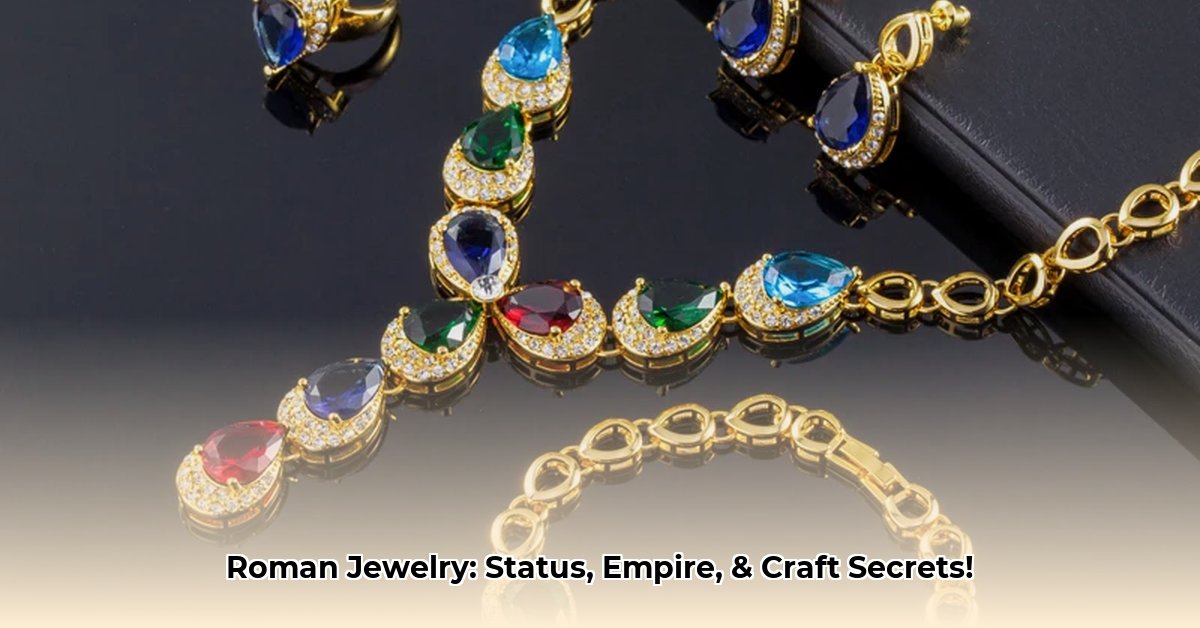Imagine a world where your personal ornaments weren’t just beautiful, but also spoke volumes about who you were, your place in society, and even your deepest beliefs. This was the vibrant reality of ancient Rome, where jewelry transcended mere adornment to become a powerful visual language of status, wealth, and identity. From the glittering gold necklaces of the elite to the humble bronze rings of commoners, each piece told a story. You can explore more about Roman Artifacts to deepen your understanding. Let’s delve into the sparkling world of Roman jewelry, exploring its pivotal role in social hierarchies, the ingenious craftsmanship that brought it to life, and its remarkable influence that continues to resonate in contemporary design.
The Resonant Language of Roman Adornment: Status and Social Stratification
In ancient Rome, jewelry served as an immediate, unmistakable social barometer. The more extravagant and precious the piece—think elaborate gold necklaces, rings sparkling with imported emeralds, or bracelets dripping with pearls and garnets—the higher the wearer’s presumed status within the rigidly structured society. These luxurious materials, often sourced from distant lands via the vast Roman trade networks, were undeniable indicators of affluence, power, and extensive connections.
For the average Roman citizen, jewelry typically consisted of more accessible materials like bronze, iron, or vibrant, colorful glass. While precise sumptuary laws dictating who could wear what were not always consistently enforced, the inherent cost of precious metals and rare gemstones naturally created a distinct visual divide. It was, in essence, a wearable caste system, instantly decipherable to anyone familiar with Roman societal codes. For instance, while commoners, known as plebeians, typically wore rings made of iron, acts of valor or exceptional service to the state could earn them the coveted right to wear gold—a subtle yet profound shift in public perception. This practice highlighted how even the simplest adornment could carry significant meaning and be tied to personal achievement. Senators, for example, were often distinguished by their prominent gold rings, sometimes featuring large, flashy gemstones, as a clear signal of their elite standing and authority.
Personal Narratives in Shimmering Gold and Stone
Beyond merely signaling wealth, Roman jewelry served as a potent form of personal expression, embodying an individual’s history, beliefs, and affiliations. Imagine wearing your personal narrative on your body; this was a common and cherished practice. A Roman matron might wear a pendant intricately engraved with the image of a beloved deity, publicly showcasing her religious devotion to gods like Isis or Venus. Men frequently wore substantial intaglio rings, not solely for decoration, but as functional seals of authority. These rings, often set with carved gemstones, were used to stamp official documents with hot wax, signifying their position, lineage, or personal signature.
Children, too, participated in this tradition. Young boys, particularly those from elite families, often sported a “bulla”—a hollow, usually gold, pendant worn around the neck from birth until they reached adulthood (around age 16). These bullae were much more than simple ornaments; they were powerful protective amulets, believed to ward off evil spirits and ensure the child’s safety and well-being. Additionally, some amulets featured a phallic symbol, known as a fascinus, also intended to provide protection against malevolent forces. Even less ornate pieces like hairpins or belt buckles could be meticulously crafted and carry symbolic weight. It is truly fascinating how a physical object could embody so many personal stories, religious beliefs, and protective intentions.
The Craft of an Empire: Materials, Mastery, and Innovation
The creation of Roman jewelry was a sophisticated process, deeply reliant on the expertise of highly skilled artisans and the vast, intricate trade networks that spanned the entire Roman Empire and extended far beyond its borders. Roman jewelers were master adapters, adept at integrating and refining design elements and techniques from the Greek, Egyptian, and Etruscan cultures they encountered and conquered. This cultural synthesis forged a unique Roman aesthetic that was both elegant and distinctly opulent.
Their craftsmanship involved a range of intricate techniques:
* Filigree: This delicate metalworking technique involved twisting fine threads of gold or silver into intricate, lace-like patterns, often forming complex scrolls or rosettes.
* Granulation: Often used in conjunction with filigree, granulation involved fusing tiny spheres of precious metal (gold or silver) onto a surface to create textured designs, adding a rich, tactile dimension.
* Intaglio: A method of carving into a gemstone or hard material to create a recessed image, often used for signet rings and personal seals.
* Cameo: The opposite of intaglio, cameos featured a raised relief image carved from layered materials, such as agate or sardonyx, showcasing an impressive command of material and artistic vision.
* Millefiori: Particularly in glasswork, this technique involved fusing together thin rods of colored glass to create intricate, mosaic-like patterns, often resembling tiny flowers, which were then sliced and incorporated into beads and ornaments.
Roman jewelers utilized a diverse palette of materials. Gold was highly prized for its luster and malleability, often associated with divinity and power. Silver was widely used for its availability and aesthetic appeal, while bronze and iron catered to wider social strata. The empire’s expansion ensured an unprecedented influx of precious and semi-precious gemstones. Emeralds from Egypt, deep red garnets, vibrant green jasper, and sky-blue lapis lazuli were imported from the East, often traveling along the fabled Silk Road. Onyx, amber (especially from the Baltic region, famously sought after by Emperor Nero’s expeditions), and moonstone came from the Persian Gulf and other distant regions. Pearls, particularly coveted for their natural beauty, were fetched from the Mediterranean and Red Seas, often incorporated into elaborate earrings called crotalia (rattles) due to their clusters of large beads. Glasswork also played an incredibly crucial role, particularly in fabricating beautiful, vibrant beads and ornaments that skillfully emulated the appearance of more precious gems, thereby making beauty and fashionable accessories more accessible to those who couldn’t afford genuine stones. So skilled were Roman glassmakers that they could often fool the public into believing their glass creations were real gems.
Major centers for jewelry production, such as Rome itself, Alexandria in Egypt, and Antioch in Syria, fostered intense innovation and specialization. These urban hubs, strategically located along key trade routes, continually pushed the boundaries of what was achievable in ancient metallurgy, gem cutting, and glass artistry, ensuring a constant flow of new designs and techniques across the empire.
The Diverse Forms of Roman Jewelry: From Practicality to Purity
The typology and variety of jewelry worn by Romans were extensive, ranging from the purely ornamental to the deeply symbolic and functional. These items adorned men, women, and children across every societal rank.
Rings
Rings were perhaps the most ubiquitous form of Roman jewelry, serving both ornamental and highly functional purposes. Gold rings were immensely popular among the elite, frequently featuring carved gemstones (intaglios or cameos) or miniature figures and deities. These were not just for show; signet rings were critical tools for sealing documents with hot wax, effectively acting as a personal signature and a symbol of the wearer’s authority and lineage. Less affluent individuals commonly wore rings made from bronze, silver, or iron. The “Herakles Knot,” a reef knot symbol, was often used in rings and other jewelry, believed to offer protection from evil spirits or signify a strong bond in marriage.
Earrings
Earrings were widely worn, especially by women, who often had pierced ears for this purpose. Designs ranged from simple hoops and studs to more elaborate pendants, sometimes featuring clusters of pearls (like the crotalia) or intricate glass beads. While less common, some men also wore earrings, though styles and frequency could vary with fashion trends and social standing.
Necklaces
Roman necklaces often consisted of chains made of gold or other metals, ornamented with gems, beads, or pendants. These pendants themselves varied widely, from simple gemstones to intricate designs featuring religious symbols, portraits, or even small lockets. Elegant necklaces could also include multiple strands of pearls or beads, showcasing the luxury and craftsmanship of Roman jewelers. The torc, a rigid metal necklace, was notably worn by soldiers as a mark of military honor and distinction, a tradition popularized by figures like Titus Manlius “Torquatus,” who earned his nickname by taking a torc from a Gaulic enemy in single combat.
Bracelets
Bracelets were common in Roman society, worn on both wrists and sometimes even upper arms. They were crafted as simple bands, intricate chains, or more complex articulated pieces. Materials varied, with solid gold snake bracelets being particularly fashionable among women, symbolizing rebirth and immortality. Other bracelets used gold pins or small screws for fastening, ensuring both security and aesthetic appeal.
Fibulae (Brooches)
These were among the most practical and widespread forms of Roman jewelry, serving primarily to fasten garments like cloaks or tunics. However, their functional role did not diminish their decorative potential. Fibulae ranged from utilitarian copper or bronze pieces worn by commoners to opulent gold brooches encrusted with gemstones and intricate designs. The “crossbow fibula,” for example, became a recognizable type, often reflecting the wearer’s military or political achievements.
Bulla and Amulets
Specifically for children, the bulla (a hollow locket, typically gold for the wealthy) was worn around the neck to protect young boys from malevolent forces until they reached manhood. Other amulets, sometimes depicting figures like a phallic symbol (fascinus) or various deities, were also common, worn by all ages for protective or religious purposes. Snake-themed jewelry, for instance, often symbolized health, healing, and immortality.
Other Adornments
Roman jewelers also created lavish hairpins, intricate belt buckles, and decorative shoe buckles, all of which could be as ornate and valuable as other jewelry types. These accessories further emphasized the Roman penchant for public display and personal adornment, ensuring that every visible element contributed to one’s overall image and status.
Enduring Echoes: Legacy and Inspiration in the Modern World
Though Roman jewelry may seem like a relic from a distant past, its influence continues to resonate profoundly in contemporary design and our understanding of ancient culture. Museums worldwide proudly display stunning examples of Roman artistry, from the exquisite pieces of the Hoxne Hoard to the intricate gold jewelry found at the Villa of the Papyri. These artifacts offer invaluable glimpses into ancient Roman life, artistry, and trade. Modern designers frequently draw direct inspiration from Roman motifs, incorporating elements like filigree work, cameos, intaglios, and the strategic use of precious metals into their own creations, demonstrating the timeless appeal of classical aesthetics.
Consider these pivotal insights gleaned from the study of Roman jewelry:
* Roman jewelry vividly communicated social standing, individuality, and faith.
* Extensive cultural influences significantly shaped Roman jewelry design, blending Greek elegance, Egyptian symbolism, and Etruscan techniques.
* Roman jewelry has left an indelible mark on contemporary design, with its stylistic elements continually reinterpreted.
* The trade networks for jewelry materials provide crucial insights into the vast economic reach and geopolitical interactions of the Roman Empire.
The Art of Sustainable Sourcing: Lessons from Antiquity for Today
Modern designers can draw profound lessons from ancient Roman jewelers, particularly concerning responsible and ethical practices. While antiquity often involved resource extraction without modern ethical considerations, the Romans’ extensive trade networks and innovative use of materials offer unique perspectives.
| Roman Era Practice | Modern Approach |
|---|---|
| Extensive trade networks, sometimes exploiting resources | Prioritizing Ethical Sourcing and Fair Trade practices ensures responsible material acquisition, with an emphasis on transparency, environmental stewardship, and direct benefits for mining communities. This includes tracing origin and supporting certified suppliers. |
| Using glass to imitate gemstones | Embracing Lab-Grown Gemstones and simulated materials as environmentally friendly and conflict-free alternatives to mined gems. These offer identical chemical, physical, and optical properties (for lab-grown) or striking visual similarities (for simulated) without ecological impact. |
Recreating Roman Elegance: Steps to Authentic Style Infusion
Want to infuse your modern wardrobe with the timeless allure of ancient Roman jewelry? Here’s how you can capture that sophisticated classical essence:
- Step 1: Start with a Foundational Piece. Choose a delicate gold chain or an understated ring crafted from a precious metal (gold or silver), echoing the elegant simplicity that often underpinned Roman ostentation. Look for pieces with subtle textures or classic geometric patterns.
- Step 2: Introduce a Focal Point with a Bold Gemstone. Explore striking garnets, captivating emeralds, or deep blue lapis lazuli—all highly prized by Romans—to infuse a touch of regal charm and vibrant color. Consider a single, prominent stone in a ring or pendant.
- Step 3: Seek Out Designs with Classical Echoes. Opt for patterns reminiscent of laurel wreaths, subtle geometric motifs, or elements borrowed from ancient mythology, such as serpents (symbolizing immortality) or miniature busts. These details will lend an authentically classical touch to your contemporary ensemble.
Roman Glass Jewelry: A Glimpse into Ancient Craftsmanship and Enduring Beauty
Roman glass jewelry, which first gained prominence around the 1st century BCE, offers a unique blend of ancient artistry and timeless appeal. It represents more than mere adornment; it is a tangible link to the Roman Empire’s vast artistic and industrial capabilities, showcasing remarkable innovation in material science. Its vibrant colors and unique, often iridescent, shimmer are not accidental but the result of advanced Roman glassmaking techniques combined with centuries of natural chemical reactions that occurred during burial.
The Romans excelled in refining glassmaking processes, producing pieces that were both aesthetically beautiful and incredibly functional. They mastered the art of adding metallic oxides to achieve a rainbow of shades, from deep cobalt blues and rich purples to verdant greens and fiery reds. Centuries of burial then performed a subtle alchemy, transforming the glass to create the coveted iridescent patina—a thin, shimmering surface layer created by layers of weathering and chemical changes over millennia. This natural process makes each unearthed piece distinct and irreplaceable. Imagine the vibrant hues of a fresh glass bead, now transformed by time into a shimmering relic.
Today’s designers recognize the inherent beauty and historical significance in ancient Roman glass fragments. They carefully incorporate salvaged pieces, often unearthed from archaeological sites in regions like Israel, into new, modern settings. These fragments evoke stories of a bygone era and occasionally reveal subtle Judaic, Christian, or Messianic influences in their original forms. This blending of old materials with new designs respects the past while creating fresh, wearable art that connects wearers directly to antiquity.
Engaging with Roman Glass Jewelry: Actionable Steps for Stakeholders
Whether you are a designer, a retailer, or a collector, understanding and interacting with Roman glass jewelry responsibly is crucial to preserving its integrity and appreciation.
For Jewelry Designers:
- Step 1: Secure Authentic Fragments. Obtain genuine Roman glass fragments from reputable, ethically vetted sources to ensure integrity and legality. Prioritize suppliers who can provide clear provenance.
- Step 2: Design with Preservation in Mind. Create settings that highlight and protect the glass’s unique iridescent beauty, allowing its historical value to shine without compromising its delicate structure. Opt for bezel settings or protective frames.
- Step 3: Establish Sustainable Sourcing. Extend sustainable sourcing practices to all other materials used in conjunction with the Roman glass, demonstrating a holistic commitment to responsible creation.
For Jewelry Retailers:
- Step 1: Educate Your Customers. Provide thorough information about the historical significance, unique properties, and preservation requirements of Roman glass, enhancing customer appreciation and understanding.
- Step 2: Provide Detailed Care Instructions. Furnish customers with precise instructions for handling, cleaning, and storing Roman glass jewelry, emphasizing gentle treatment to preserve its delicate integrity and iridescence.
- Step 3: Consider Cultural Partnerships. Explore collaborations with cultural organizations, museums, or historical societies to offer unique events, exhibitions, or educational programs centered around Roman artifacts.
For Jewelry Collectors:
- Step 1: Verify Authenticity. Always confirm the authenticity of each piece through expert appraisal or by purchasing from highly reputable dealers to ensure your investment is genuine and historically accurate.
- Step 2: Handle with Extreme Care. Store and handle pieces with the utmost care, protecting them from physical damage, especially from moisture, extreme temperatures, and sudden impacts, all of which can degrade the fragile glass.
- Step 3: Support Preservation Initiatives. Contribute to and advocate for preservation initiatives for ancient artifacts, thereby aiding in the ongoing study, protection, and responsible display of cultural heritage for future generations.
The Delicate Beauty of Ancient Glass: Weighing Pros and Cons
Roman glass jewelry, while breathtaking, demands respect due to its inherent fragility. It is notably sensitive to water exposure, which can diminish its luster and potentially cause structural damage over time by accelerating the weathering process. Despite this vulnerability, its irreplaceable beauty and profound historical value make it well worth the extra care and responsible stewardship.
Consider these aspects when contemplating Roman glass jewelry:
| Pros | Cons |
|---|---|
| Direct, tangible connection to ancient history | Requires exceptionally gentle handling to prevent damage |
| Unique iridescent appearance due to millennia of aging | Highly susceptible to water damage, necessitating careful wear |
| Supports ethical sourcing when done responsibly (for fragments) | Authentic sourcing can be challenging and requires diligent research |
| Offers a captivating conversation piece and unique aesthetic | Authentication can be challenging for inexperienced buyers and requires expertise |
Roman glass jewelry offers an unparalleled opportunity to possess a tangible piece of ancient history. Whether you are a designer crafting new pieces, a retailer curating unique collections, or a collector seeking historical treasures, understanding its origins, the sophisticated glassmaking techniques involved, and its inherent fragility will deepen your appreciation for its timeless appeal and ensure its legacy endures.
Roman Jewelry Designs: A Future-Proof Legacy of Art and Influence
The Roman Empire, with its vast geographical reach, formidable military might, and profound cultural assimilation, birthed jewelry designs that mirrored its core values: a deep-seated reverence for status, a clear display of wealth, and the cultivation of a distinct cultural identity. From the relatively simple beginnings influenced by the Etruscans, Roman designs evolved into opulent displays of intricately worked gold and dazzling precious gemstones, reflecting a society that valued public display and personal magnificence.
Consider how these designs carried deep symbolic meaning. Snake motifs, for instance, were not merely decorative elements; they embodied powerful concepts of immortality, rebirth, and healing—potent beliefs deeply woven into Roman culture. Rings featuring clasped hands (fede rings) vividly symbolized engagement, marriage, and loyalty, a direct visual representation of unity and enduring bonds. Gemstones, sourced from the far-flung corners of the empire—vibrant emeralds from Egypt, radiant peridots from the Red Sea, and mystical lapis lazuli from as far as Afghanistan—were not only beautiful additions but also functioned as tangible trophies, showcasing Rome’s vast territorial and economic reach. Even glass, a more accessible material, was ingeniously employed to imitate more expensive gems, allowing broader segments of society to make fashionable statements without the exorbitant cost.
The genius of Roman jewelers lay in their mastery of intricate techniques, many of which were inherited and perfected from earlier cultures. They refined filigree (delicate metalwork), granulation (fusing tiny metal beads onto a surface), and intaglio (engraved gemstones, creating a recessed image). Cameos, featuring raised relief images, and intaglios, with their finely engraved scenes, were particularly prized for their artistic merit and served as miniature works of art, reflecting the refinement and cultural sophistication of the wearer. A single intaglio ring, for example, could function as a personal signature, an official seal, and a compact work of art all at once. The mass production of molds and casting techniques, unlike earlier Greek practices, further allowed Roman jewelry to be more widely distributed and affordable, making these adornments accessible to a larger populace while still maintaining a clear social hierarchy in materials used.
Why does Roman jewelry matter today? Because its influence is undeniably potent and enduring. Roman designs have inspired countless generations of jewelers, with echoes of their iconic snake bracelets, intricate fibulae, and laurel wreaths still prominently visible in modern collections. Museums worldwide continue to showcase Roman jewelry as central exhibits, offering invaluable glimpses into this complex ancient world and its artistic achievements. Furthermore, studying these exquisite artifacts provides critical insights into the intricate trade routes, powerful economic dynamics, and profound cultural exchanges that fundamentally shaped the Roman Empire over centuries. The artistic legacy of Rome, particularly in its jewelry, truly proves its timeless appeal, demonstrating how beauty, status, and craftsmanship intertwine across millennia. Even after the fall of the Roman Empire, its artistic influence lived on, notably in Byzantine jewelry, which, while developing its own distinct characteristics, retained many fundamental Roman elements, demonstrating the powerful and persistent nature of Roman artistic traditions.
- Unveiling ancient roman gladiator helmets design secrets that decided victory or death - August 14, 2025
- Unlocking ancient roman domes: Innovation secrets for modern builds, like the Pantheon - August 14, 2025
- Unlock Ancient Secrets: Ancient Roman Money, Empire’s Rise, a Collector’s Guide - August 14, 2025
















